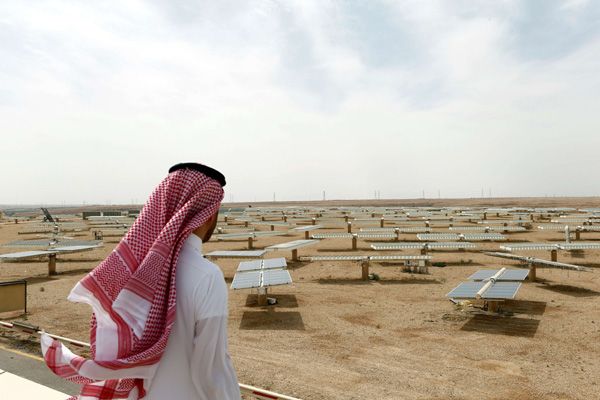We show you our most important and recent visitors news details Lower solar energy cost can lead to brighter future in the following article
Hind Al Soulia - Riyadh - The price of solar, averaging about 0.05 USD/kWh, has reached the low that the International Energy Agency previously predicted would not arrive until the middle of the century.
An Emirati man stands in front of rows of parabolic shaped mirrors at the Shams 1, Concentrated Solar power (CSP) plant, in al-Gharibiyah district on the outskirts of Abu Dhabi. (AFP)
LONDON- The arrival of low cost sunlight-to-energy conversion has come decades earlier than predicted, pushing a clean energy system transition ahead at an encouraging pace.
The price of solar, averaging about 0.05 USD/kWh, has reached the low that the International Energy Agency (IEA) previously predicted would not arrive until the middle of the century. Costs have now sunk so low that they are cheaper than fossil fuels, even before considering climate change and air pollution costs.
The global energy sector is responsible for almost three fourths of global greenhouse gas emissions, which primarily come from gas, oil and coal burning. As governments attempt to decarbonise their electricity grids in order to meet the agreed target of limiting global warming by no higher than 2 degrees C, these declining prices matter immensely for climate change.

The previous cheapest electricity generating method, coal, is now struggling to keep up with solar. An analysis published by London-based think tank Carbon Tracker Initiative in March suggested that the struggle risks wasting over $600 billion through coal projects. They predict that in the next decade, it will be cheaper to shut down coal-fired plants, such as the Hassyan Clean Coal Power Plant in Dubai, and replace them with new wind and solar plants.
In April 2020, Abu Dhabi signed a deal for solar energy at 0.0135 USD/kWh, even lower than the deals signed in Dubai and Qatar that broke records in early 2020.
On June 2, the International Renewable Energy Agency (IRENA) published a report highlighting that in 2019, the renewable power generation costs added had lower power costs when compared to even the cheapest new coal plants.
The report revealed how in 2021, up to 12000GW of existing coal capacity could well exceed the cost of new utility-scale solar photovoltaic panels.
Replacing the most costly 200GW of coal for onshore wind and solar PV could lead to a reduction of annual emissions of up to 1.8 gigatons of CO2, the equivalent of 5% of the total global CO2 emissions in 2019, as well as a cut of $23 billion to power system costs each year.
IRENA Director General Francesco La Camera stressed that any global recovery strategy must be a green strategy. “Renewables offer a way to align short-term policy action with medium- and long-term energy and climate goals. Renewables must be the backbone of nationale doors to restart economies in the wake of the COVID-19 outbreak,” Camera said. “With the right policies in place, falling renewable power costs, can shift markers and contribute greatly towards a green recovery,”
In its findings, IRENA identified that renewable electricity costs have fallen over the past decade, caused by growing experience, economies of scale, improving technology and an increase in competitive supply chains. When compared to 2010 costs, solar PV power showed the greatest decline, falling by 82%, with concentrations solar power following at 47%, onshore wind at 39% and offshore wind with the least decline, at 29%.
Every year, these costs continued to fall, with Solar PV falling 13% in 2019, achieving an average global og of 0.068USD/kWh.
This decline in price is largely thanks to Germany, where over half its power mix is made up of renewables. Each time solar capacity doubles, the total price of solar energy falls by around 30%. This relationship is called a learning curve by analysts and as more plants are replayed, the more technology comes down in price. This is due to the country’s demand for solar power which “not only installed a lot of solar, but it catalysed the learning curve” said Gregory Nemet, a professor at the University of Wisconsin-Madison and author of “How Solar Became Cheap: A Model for Low-Carbon Innovation.”
Egyptian-born clean energy advocate Ramez Naam released an analysis in May 2020 suggesting that by 2035, average solar prices shall hit 0.01 USD.kWh if things continue on their current track. “In a purely open market, these incredibly low prices would drive the world’s remaining coal plants into bankruptcy, and steal some of the most profitable operating hours even from cheap natural gas plants,” he wrote in the report.
However other analysts do not share his optimism, questioning whether this learning rate corresponds to the capital costs or can be applied to the total cost of solar.
Sunny countries in the Middle East and North Africa (MENA) have had solar price predictions fluctuate from below 0.01 USD/kWH all the way to 0.025 USD/kWh, which even at its highest suggested cost, is still below the cost of running coal plants.
A potential issue is that electricity prices are lowered as renewable energy spreads through the grid, which chips away at suppliers’ revenues, offsetting technology cost gains when solutions for better storage and demand are met. However, these fields are making progress quickly. Electric vehicles can be charged at night to spread out demand and battery technologies are following solar technologies rapid developments. Nemet noted that newfound access to abundant and cheap solar energy “gives us a tool that we didn’t have in the past.”
Omar El-Huni is a contributor to The Arab Weekly on environmental issues. He is a graduate of the University of Reading on environmental matters.
These were the details of the news Lower solar energy cost can lead to brighter future for this day. We hope that we have succeeded by giving you the full details and information. To follow all our news, you can subscribe to the alerts system or to one of our different systems to provide you with all that is new.
It is also worth noting that the original news has been published and is available at The Arab Weekly and the editorial team at AlKhaleej Today has confirmed it and it has been modified, and it may have been completely transferred or quoted from it and you can read and follow this news from its main source.




